-
Templates
1099 FormsAccurately report 1099 information returns and ensure IRS filing with easeExplore all templatesW-9 W-8 FormsEasily manage and share taxpayer details to streamline payments and meet IRS requirements with confidenceExplore all templatesOther Tax FormsFillable tax forms simplify and speed up your tax filing process and aid with recordkeeping.Explore all templatesReal EstateReal estate templates for all cases, from sale to rentals, save you a lot of time and effort.Explore all templatesLogisticsSimplify your trucking and logistics paperwork with our ready-to-use transportation and freight templates.Explore all templatesMedicalMedical forms help you keep patient documentation organized and secure.Explore all templatesBill of SaleBill of Sale templates streamline the transfer of ownership with clarity and protection.Explore all templatesContractsVarious contract templates ensure efficient and clear legal transactions.Explore all templatesEducationEducational forms and templates enhance the learning experience and student management.Explore all templates
-
Features
FeaturesAI-Enhanced Document Solutions for Contractor-Client Success and IRS ComplianceExplore all featuresAI Summarizer Check out the featureAI PDF summarizer makes your document workflow even faster. Ask AI to summarize PDF, assist you with tax forms, complete assignments, and more using just one tool.Sign PDF Check out the featurePDFLiner gives the opportunity to sign documents online, save them, send at once by email or print. Register now, upload your document and e-sign it onlineFill Out PDF Check out the featurePDFLiner provides different tools for filling in PDF forms. All you need is to register, upload the necessary document and start filling it out.Draw on a PDF Check out the featureDraw lines, circles, and other drawings on PDF using tools of PDFLiner online. Streamline your document editing process, speeding up your productivity
- Solutions
- Features
- Blog
- Support
- Pricing
- Log in
- Sign Up
30-Day Notice to Vacate Forms
-
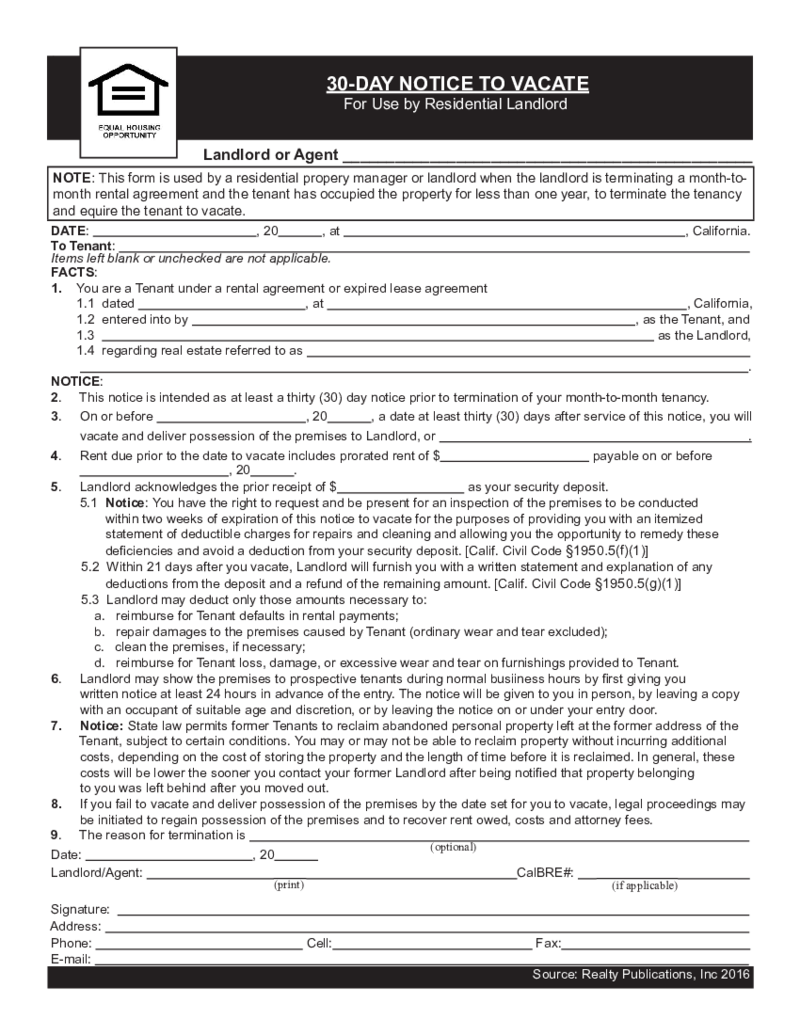 30-Day Notice To Vacate
What Is a 30-Day Notice to Vacate Template?
The 30 day notice to vacate is sent by the landlord or property manager to the renter. The form informs t
30-Day Notice To Vacate
What Is a 30-Day Notice to Vacate Template?
The 30 day notice to vacate is sent by the landlord or property manager to the renter. The form informs t
-
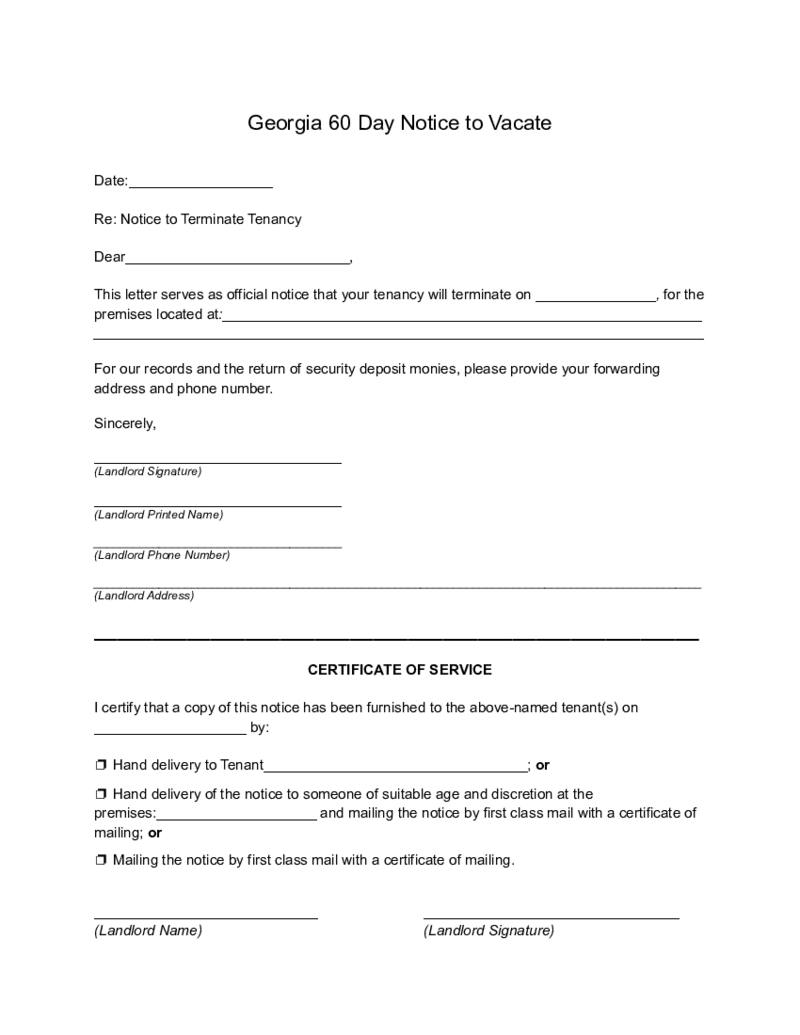 60 Day Notice to Vacate Georgia
What Is Georgia 60 Day Notice to Vacate Form?
A 60 Day Notice to Vacate Form is a legal document that landlords use to notify tenants about their intention to terminate a lease agreement. In Georgia, tenants who are renting a property under a lease agreem
60 Day Notice to Vacate Georgia
What Is Georgia 60 Day Notice to Vacate Form?
A 60 Day Notice to Vacate Form is a legal document that landlords use to notify tenants about their intention to terminate a lease agreement. In Georgia, tenants who are renting a property under a lease agreem
-
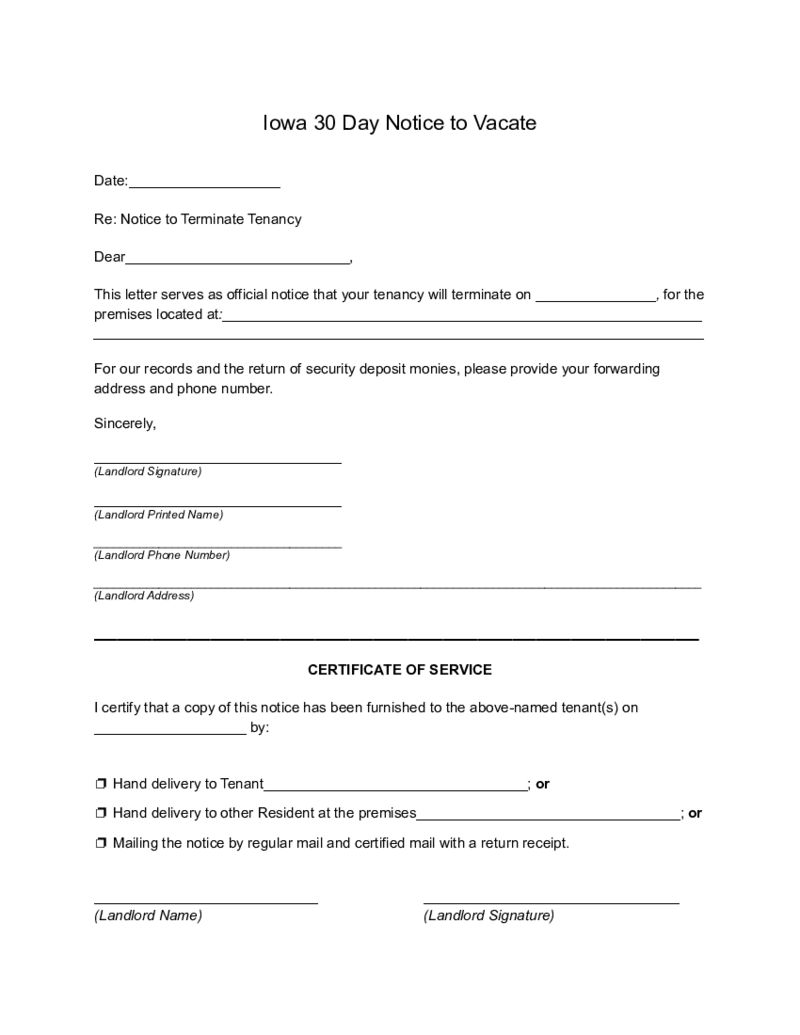 Iowa, 30 Day Lease Termination Notice Form
What Is a 30 Day Notice to Terminate Lease Form
A 30-day Notice to Terminate a Lease Form is a crucial document used in real estate, specifically in rental agreements in Iowa. This form is a written statement by either the landlord or the tenant indicatin
Iowa, 30 Day Lease Termination Notice Form
What Is a 30 Day Notice to Terminate Lease Form
A 30-day Notice to Terminate a Lease Form is a crucial document used in real estate, specifically in rental agreements in Iowa. This form is a written statement by either the landlord or the tenant indicatin
-
 Utah 30 Day Notice to Vacate
What Is a Utah 30 Day Notice to Vacate Form?
A 30 day notice to vacate Utah form is a legal document that notifies a tenant that they must vacate a rental property. This document is typically used when a tenant has violated the terms of their lease agreem
Utah 30 Day Notice to Vacate
What Is a Utah 30 Day Notice to Vacate Form?
A 30 day notice to vacate Utah form is a legal document that notifies a tenant that they must vacate a rental property. This document is typically used when a tenant has violated the terms of their lease agreem
-
 Ohio 30 Day Notice to Vacate
What is 30 Day Notice to Vacate Ohio?
The 30 day notice to vacate Ohio is the document that is usually agreed by the tenant and the landlord. This is the notice that either landlord or tenant provides to the other party to notify about the intention to em
Ohio 30 Day Notice to Vacate
What is 30 Day Notice to Vacate Ohio?
The 30 day notice to vacate Ohio is the document that is usually agreed by the tenant and the landlord. This is the notice that either landlord or tenant provides to the other party to notify about the intention to em
-
 Pennsylvania Eviction Notice
What Is a Pennsylvania Eviction Notice?
The Pennsylvania Landlord Association (PLA) has designed a form called LAFM009, which is also known as the "Notice to Vacate" form. The form is intended to be used by landlords in Pennsylvania when they ne
Pennsylvania Eviction Notice
What Is a Pennsylvania Eviction Notice?
The Pennsylvania Landlord Association (PLA) has designed a form called LAFM009, which is also known as the "Notice to Vacate" form. The form is intended to be used by landlords in Pennsylvania when they ne
-
 Tennessee 30 Day Lease Termination Notice
What Is a 30 Day Lease Termination Notice Tennessee
A 30-Day Lease Termination Notice in Tennessee is a formal document a landlord or tenant uses to terminate a month-to-month rental agreement. This notice provides the other party with a 30-day warning th
Tennessee 30 Day Lease Termination Notice
What Is a 30 Day Lease Termination Notice Tennessee
A 30-Day Lease Termination Notice in Tennessee is a formal document a landlord or tenant uses to terminate a month-to-month rental agreement. This notice provides the other party with a 30-day warning th
-
 Oklahoma 30 Day Lease Termination Notice
Oklahoma 30 Day Lease Termination Notice: A Comprehensive Guide
Navigating through lease agreements can be tricky, but it doesn't have to be! With the Oklahoma 30 Day Lease Termination Notice Form readily available on PDFliner, tenants and landlords c
Oklahoma 30 Day Lease Termination Notice
Oklahoma 30 Day Lease Termination Notice: A Comprehensive Guide
Navigating through lease agreements can be tricky, but it doesn't have to be! With the Oklahoma 30 Day Lease Termination Notice Form readily available on PDFliner, tenants and landlords c
-
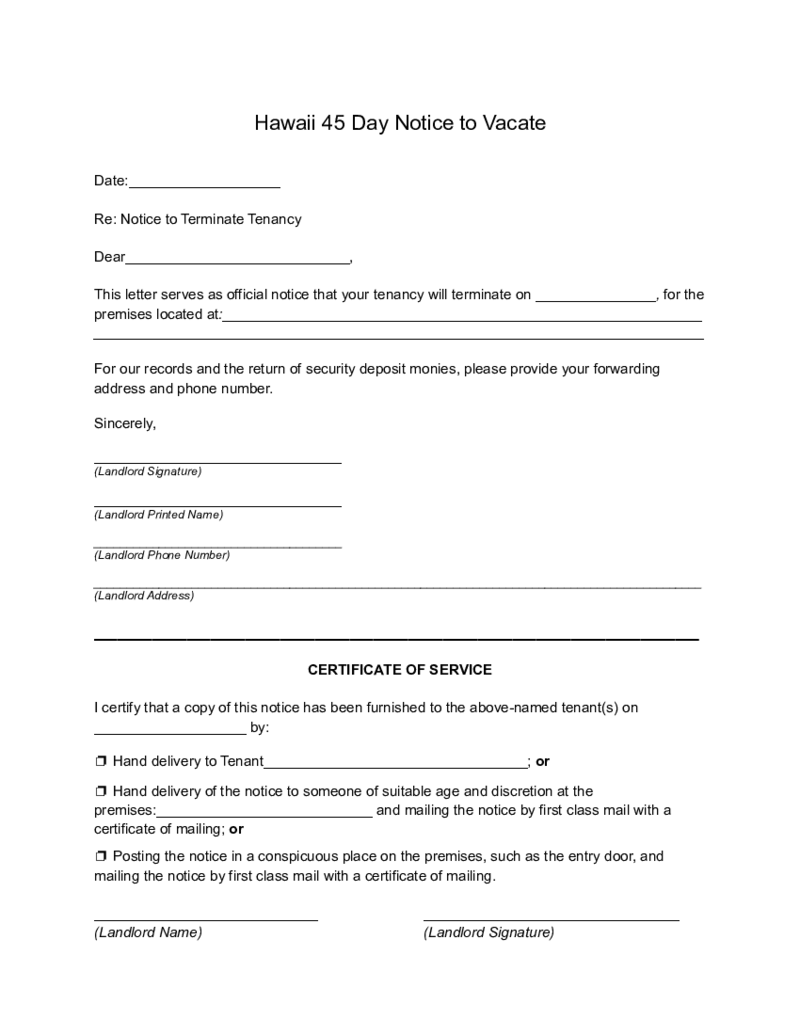 Hawaii 45 Day Notice to Vacate
What Is the Hawaii 45 Day Notice to Vacate Form?
The 45 days notice to vacate Hawaii form is a written notice that tenants must give their landlord to inform them that they will be moving out of the rental property. This form is required by law, and failu
Hawaii 45 Day Notice to Vacate
What Is the Hawaii 45 Day Notice to Vacate Form?
The 45 days notice to vacate Hawaii form is a written notice that tenants must give their landlord to inform them that they will be moving out of the rental property. This form is required by law, and failu
-
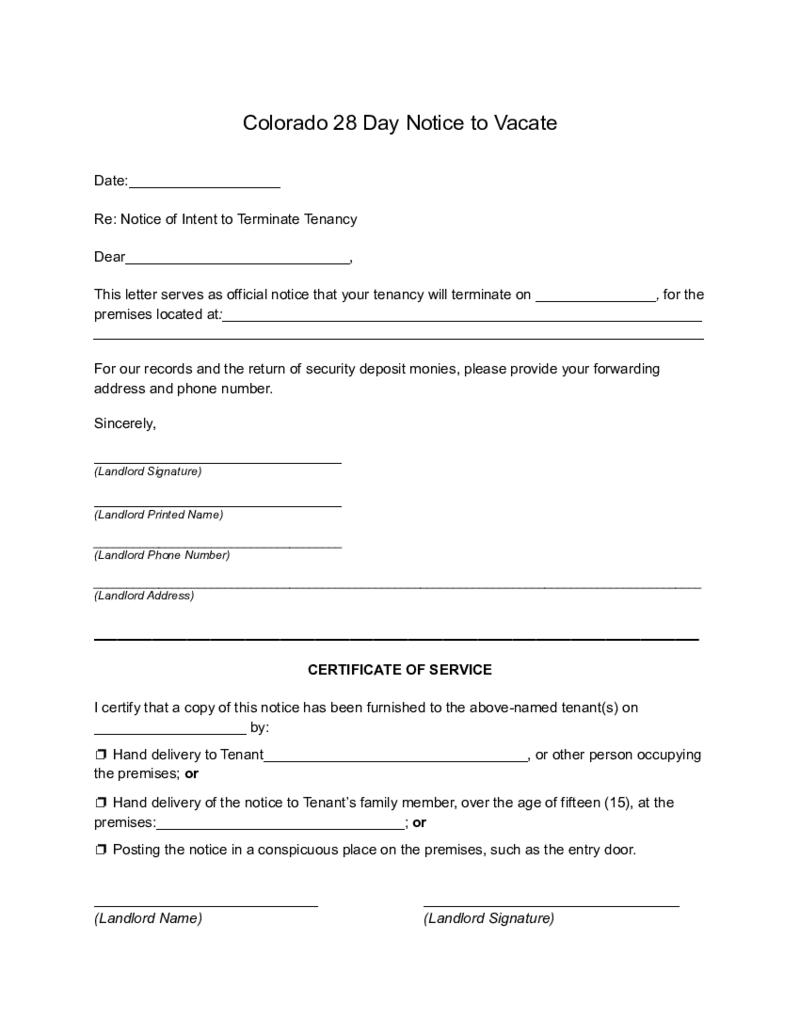 Colorado Lease Termination Letter Form, 30-Day Notice
What Is Colorado Lease Termination Letter Form, 30-Day Notice?
A lease termination letter is a written notice given by a tenant to their landlord to inform them that they intend to move out of the property before the lease agreement ends. In Colorado, lan
Colorado Lease Termination Letter Form, 30-Day Notice
What Is Colorado Lease Termination Letter Form, 30-Day Notice?
A lease termination letter is a written notice given by a tenant to their landlord to inform them that they intend to move out of the property before the lease agreement ends. In Colorado, lan
-
 Michigan 30 Day Notice to Vacate
Understanding the Michigan 30 Day Notice to Vacate Form
The 30 day notice to vacate is a rule that applies to many housing situations across the United States, including Michigan. This important legal document, typically dictated by the terms of a lease,
Michigan 30 Day Notice to Vacate
Understanding the Michigan 30 Day Notice to Vacate Form
The 30 day notice to vacate is a rule that applies to many housing situations across the United States, including Michigan. This important legal document, typically dictated by the terms of a lease,
-
 Kentucky 30 Day Notice to Vacate
Understanding the Kentucky 30 Day Notice to Vacate
In dealing with rental properties, familiarizing oneself with legal forms is an essential step for both landlords and tenants. One such form is the 30-day notice to vacate form in Kentucky. This for
Kentucky 30 Day Notice to Vacate
Understanding the Kentucky 30 Day Notice to Vacate
In dealing with rental properties, familiarizing oneself with legal forms is an essential step for both landlords and tenants. One such form is the 30-day notice to vacate form in Kentucky. This for
Search by State
What Are 30-Day Notice to Vacate Forms?
The 30-Day Notice to Vacate Template is the document that allows one of the parties of the rent agreement to cancel the lease. It is made by the landlord or tenant based on the type of form you pick. The template has to be created according to local law. On PDFLiner, you will find a wide range of such templates almost for every state. You can also pick a universal Landlord 30-Days Notice to Vacate blank and make sure that it matches the state laws you live in.
You have to send this template in advance so that the other party has 30 days to vacate the place or find a new tenant. It is necessary to fill out this form if you want to stop the contract with the other party over the rented property. The letter formally announces your plans, so you don’t have to pay the next rent or expect the payment.
Types of Termination Letters
There are several types of letters of termination, and sometimes people are lost in their variety. To make sure you pick the right one, you have to learn the differences between them. It can help you to fill the document in no time with only appropriate information. Here they are:
Landlord’s Notice to Terminate
This document is provided by the landlord who wants to stop the deal with the tenant. It usually contains details on the contract’s end. It can be made as a formal farewell. During the next 30 days, the tenant has to find a new house and leave the current one. Tenants can ask the landlord to write positive notes that will be shown to the next landlord. The landlord does not have to explain the demand.
Tenant’s Notice to Vacate
The tenant sends a 30-Day Notice to Vacate for the Landlord to stop their agreement on the property. It can also be sent to the property manager. The document announces the plans to vacate the rented property. Within 30 days, the landlord can find a new tenant.
Mutual Agreement to Terminate Lease
Both parties can agree to end the relationship. They end the lease via mutual termination. The terms can be provided by both parties and negotiation before the document is filled out. However, this agreement is still voluntary, and if one party does not want to sign it, the other can use the tenant or landlord document for termination.
Eviction Notice
This is one of the least popular termination letters; however, tenants can still receive it from the landlord. This document states that the tenant somehow committed a violation of the lease, and the landlord asks to vacate the property. In this case, the landlord can specify the deadline for the vacation. It can be less than 30 days. Tenants can disagree and use this document as proof in court. Yet, there will be no termination of the letter after the deadline.
How to Fill Out a 30-Day Notice to Vacate Form
If you want to fill out the form, you can find it on PDFLiner, as well as instructions for the procedure. No matter whether you fill out the Tenant 30-Days Notice to Vacate blank or an eviction notice, you have to be aware of the specifics. Both these documents have similar fillable fields. Here is your step-by-step instruction:
- Write down the name, address, and phone number of the tenant.
- Provide the name and address of the landlord.
- Share the facts about the lease agreement, including the date when it was signed, the address of the real estate, and the amount of payment for each month.
- Notify the other party to include the due date, the amount of money that must be paid, and any extra conditions that must be agreed upon.
- Put the current date and signature.
Common Mistakes to Avoid When Using a 30-Day Notice to Vacate
While a 30-Day Notice to Vacate by a Tenant looks simple to fill in, they can still make mistakes in the document. In this case, the landlord may decline the template. However, if the landlord did not notice mistakes and signed it, the document may be treated as illegal or invalid. Here are the most common mistakes made in the document:
- No current date on the agreement. The tenant provides the date that is considered to be the deadline for the end of the lease. This is a huge mistake;
- The document is not signed. No matter if all the other sections are filled out, without the signature of at least one party, the document is invalid;
- The payment mentioned in the document is not correct. In this case, the landlord can ask to fix the document before the deadline. It may be unaccepted in court as proof;
- The document is made according to the other state laws. In this case, it is not valid in its current state.
No matter which of these mistakes you make, if the other party notices it, the document can still be fixed. However, if the form goes to court, it may be considered invalid.
FAQ:
-
What happens if I don't give a 30-day Notice to Vacate?
If you don’t give the notice at the appropriate time, the landlord may not accept it. Moreover, you will still need to wait for 30 days and pay for them. Landlord has to find another tenant or close the rent during these days. Your obligation is to notify the landlord in advance. You may be asked to pay an extra fee for the inconvenience.
-
Can a landlord refuse to accept a 30-Day Notice to Vacate Form?
If the document is made inappropriately, the landlord may refuse to sign the form. However, if you believe that the form is made according to the law, you can go to court and prove your point of view. Usually, the landlord has to accept the template from the tenant.
-
What if my landlord doesn't give me a 30-Day Notice to Vacate?
If the landlord does not give the form in advance, you don’t need to leave the property. You can go to court and prove your point. You can also ask the real estate agent you deal with for help.
-
How do I know if I need to give a 30-Day Notice to Vacate?
If you want to move out, you have to fill out this document. You have to notify the other party about your intentions and prepare the standard paper. Yet, if you both agree upon the mutual agreement to terminate the lease, you don’t have to wait for 30 days.


























































